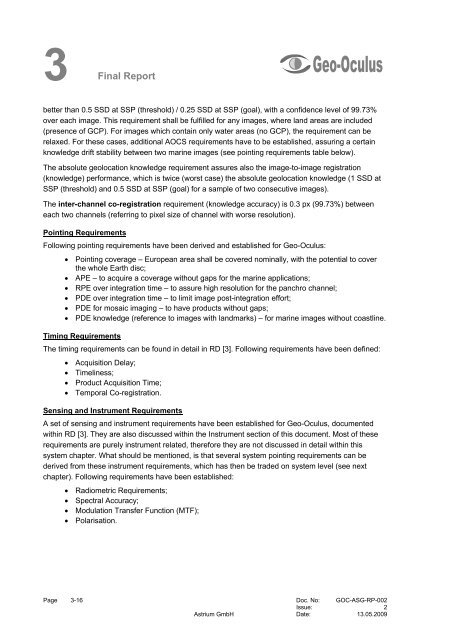4 Final Report - Emits - ESA
4 Final Report - Emits - ESA
4 Final Report - Emits - ESA
Create successful ePaper yourself
Turn your PDF publications into a flip-book with our unique Google optimized e-Paper software.
3 <strong>Final</strong><br />
<strong>Report</strong><br />
better than 0.5 SSD at SSP (threshold) / 0.25 SSD at SSP (goal), with a confidence level of 99.73%<br />
over each image. This requirement shall be fulfilled for any images, where land areas are included<br />
(presence of GCP). For images which contain only water areas (no GCP), the requirement can be<br />
relaxed. For these cases, additional AOCS requirements have to be established, assuring a certain<br />
knowledge drift stability between two marine images (see pointing requirements table below).<br />
The absolute geolocation knowledge requirement assures also the image-to-image registration<br />
(knowledge) performance, which is twice (worst case) the absolute geolocation knowledge (1 SSD at<br />
SSP (threshold) and 0.5 SSD at SSP (goal) for a sample of two consecutive images).<br />
The inter-channel co-registration requirement (knowledge accuracy) is 0.3 px (99.73%) between<br />
each two channels (referring to pixel size of channel with worse resolution).<br />
Pointing Requirements<br />
Following pointing requirements have been derived and established for Geo-Oculus:<br />
• Pointing coverage – European area shall be covered nominally, with the potential to cover<br />
the whole Earth disc;<br />
• APE – to acquire a coverage without gaps for the marine applications;<br />
• RPE over integration time – to assure high resolution for the panchro channel;<br />
• PDE over integration time – to limit image post-integration effort;<br />
• PDE for mosaic imaging – to have products without gaps;<br />
• PDE knowledge (reference to images with landmarks) – for marine images without coastline.<br />
Timing Requirements<br />
The timing requirements can be found in detail in RD [3]. Following requirements have been defined:<br />
• Acquisition Delay;<br />
• Timeliness;<br />
• Product Acquisition Time;<br />
• Temporal Co-registration.<br />
Sensing and Instrument Requirements<br />
A set of sensing and instrument requirements have been established for Geo-Oculus, documented<br />
within RD [3]. They are also discussed within the Instrument section of this document. Most of these<br />
requirements are purely instrument related, therefore they are not discussed in detail within this<br />
system chapter. What should be mentioned, is that several system pointing requirements can be<br />
derived from these instrument requirements, which has then be traded on system level (see next<br />
chapter). Following requirements have been established:<br />
• Radiometric Requirements;<br />
• Spectral Accuracy;<br />
• Modulation Transfer Function (MTF);<br />
• Polarisation.<br />
Page 3-16 Doc. No: GOC-ASG-RP-002<br />
Issue: 2<br />
Astrium GmbH Date: 13.05.2009

















